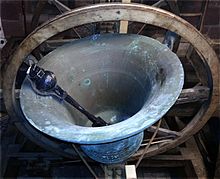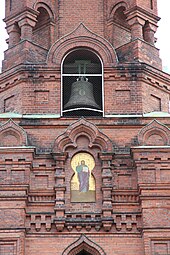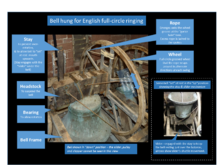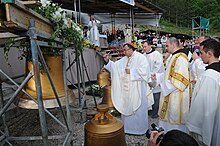교회 종소리
Church bell기독교 건축에서 교회 종은 다양한 종교적 목적을 위해 교회에서 울리는 종으로 건물 밖에서 들을 수 있다.전통적으로 그들은 예배자들을 교회로 불러들여 공동 예배를 드리고, 매일 기독교의 정해진 기도 시간을 알리는 데 사용됩니다. 정례적인 시간이라고 불리는 시간은 7번이고 간결한 시간에 포함되어 있습니다.그들은 또한 결혼식이나 장례식 같은 특별한 행사에서도 울린다.일부 종교적 전통에서는 예배의 특정 부분에 [1]도달했음을 사람들에게 알리기 위해 예배의 예배 내에서 사용됩니다.기독교 전통에서 교회 종소리는 또한 [2][3][4]악마를 쫓아낸다고 믿어진다.
전 세계 기독교 교회에서 사용되는 전통적인 유럽 교회 종(컷어웨이 그림 참조)은 컵 모양의 금속 공명기로 구성되어 있으며, 그 안에 종이 흔들릴 때 옆을 때리는 추축 딱지가 매달려 있다.그것은 교회나 [5]종교 건물의 첨탑이나 종탑 안에 걸려 있어서 소리가 넓게 퍼질 수 있다.이러한 종은 제자리에 고정되거나('행 데드'), 또는 피벗 빔('헤드 스톡')에 매달려 앞뒤로 흔들릴 수 있습니다.밧줄은 헤드스톡에 부착된 레버나 바퀴에 매달려 있으며, 벨을 울리면 벨이 앞뒤로 흔들리고 찰과자가 안쪽에 부딪히면서 벨을 울린다.죽은 채로 매달린 종은 보통 망치로 소리 활을 치거나 때로는 내부의 딱지를 종에 대고 당기는 밧줄로 소리를 낸다.
교회는 하나의 종이나 공통 음계에 맞춰 조정된 종들의 모음을 가질 수 있다.그것들은 정지해 있고 울리고, 작은 호를 통해 무작위로 울리거나, 영어 변화 울림의 고도의 제어를 가능하게 하기 위해 완전한 원을 통해 울릴 수 있다.
현대 통신 이전에, 교회 종은 모든 목적을 위해 공동체를 부르는 흔한 방법이었다. 신성하고 세속적인 것 모두.
용도 및 전통
기도를 외치다
콥트교와 인도교도와 같은 동양 정교회 교인들은 아그페야교와 셰히모교와 같은 짧은 기도문을 사용하여 동쪽을 향해 하루에 일곱 번 기도한다; 교회 종은, 특히 수도원에서, 이 일곱 개의 고정된 기도 [6][7]시간을 기념하기 위해 울린다.
기독교에, 어떤 교회들 belltowers 하루에 세번에서 9시까지인지라, 12시부터 오후 3시 주 기도문 암송하는 데 기독교 신자들을 소환할;[8][9][10] 그 가처분 명령은 주님의 기도 세번 신문 Didache 8,2에 기도하기에 그들의 교회 종이 울리f.,[11][12][13]을 차례로 thr 기도하는 유대인 연습하여 영향을 받았다.아이스가 매일 발견했다.구약성서, 특히 "저녁과 아침과 정오"를 암시하는 시편 55장 17절과 예언자 다니엘이 [11][12][14][15]하루에 세 번 기도하는 다니엘 6장 10절에 나옵니다.그래서 초기 기독교인들은 오전 9시, 낮 12시,[16] 오후 3시에 주기도회를 하러 왔다.
많은 가톨릭 교회들은 신자들에게 신의 화신을 [17][18]기리는 기도인 엔젤루스를 낭송하라고 부르기 위해 매일 오전 6시, 낮 12시, 오후 6시에 종을 세 번 친다.
일부 개신교 교회에서는 설교 후 주기도회 총회 낭독 중에 교회 종을 울려 참석하지 못하는 사람들에게 "회중과 단결하라"[19][20]고 경고한다.
많은 역사적인 기독교 교회에서는 촛불과 종려나무 [22]일요일의 행렬뿐만 아니라 모든 성도의 [21]전야제에도 교회 종이 울립니다; 교회 종이 울리지 않는 기독교 해 중 유일한 시간은 부활절 [23]자경절인 목요일부터 문디입니다.종탑에서 교회 종이 울리는 기독교 전통은 미나레에서 [24][25]나오는 아단의 이슬람 전통과 유사합니다.
예배의 외침
대부분의 기독교 종파들은 예배의 시작이나 [19][26]미사의 시작을 알리며 신도들을 예배에 부르기 위해 교회 종을 울립니다.
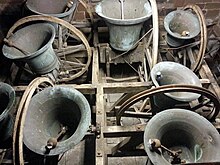
영국 성공회에서는 예배 전 약 30분 동안 원형 타워 벨을 울리는 변화의 강한 전통이 있다.이것은 17세기 초에 종을 치는 사람들이 큰 호를 통해 종을 휘두르는 것이 탁자의 연속적인 타격 사이의 시간을 더 잘 조절한다는 것을 발견했을 때 유래되었다.이것은 완전한 원을 통해 종을 울리는 것으로 절정을 이뤘고, 이것은 벨을 울리는 사람들이 쉽게 다른 놀라운 순서, 즉 변화라고 알려진 것을 만들어 낼 수 있게 해준다.
악마의 엑소시즘
기독교에서, 교회 종소리는 전통적으로 악마와 다른 더러운 영혼들을 [2][27][4]쫓아낸다고 믿어진다.교회 종소리의 목적과 관련된 교회 종소리와 기도와 예배의 부르짖는 목적, 예를 들어 "이 종소리의 소리는 폭풍우를 물리치고, 악마를 물리치고,[3] 사람을 부른다"는 관습이 있었다.어떤 교회들은 "교회가 종을 많이 칠수록 더 크게 울리고, 그들이 들을 수 있는 거리가 멀수록,[27] 사악한 세력이 교구를 괴롭힐 가능성이 적었다"는 명분을 가진 여러 개의 종을 가지고 있다.
장례식 및 추모의 울림
영국 전통에서 죽음을 알리는 교회의 종을 울리는 것을 죽음의 종소리라고 합니다.타격의 패턴은 죽은 사람에 따라 달랐다. 예를 들어 영국의 켄트와 서리 카운티에서는 남자에게는 3번, 여자에게는 3번 울리는 것이 관례였으며,[28] 어린이에게는 다양한 용법이 적용되었다.그리고 나서 고인의 나이가 나왔다.작은 정착촌에서 이것은 누가 방금 [29]죽었는지 효과적으로 확인할 수 있었다.
죽음을 둘러싸고 종을 울릴 수 있는 세 번의 사건이 있었다.죽음이 임박했음을 알리는 "통과하는 종"이 있었고, 죽음을 알리는 두 번째 "죽음의 종"이 있었고, 마지막은 장례식에서 행렬이 [29]교회에 가까워질 때 울리는 "리치 종" 즉 "시립종"이 있었다.후자는 오늘날 장례식 피해로 알려져 있다.
원형의 종이 있는 보다 현대적인 전통은 하나의 종을 울릴 때 "반쪽 머플"을 톨드 벨로 사용하거나 모든 종을 바꿀 때 사용하는 것이다.이것은 가죽 머플을 각 종에 달아서 큰 "열린" 타격이 있고 그 후에 소음된 타격이 발생하도록 하는데, 이것은 매우 우렁차고 슬픈 효과를 가져온다.영국의 전통은 군주의 죽음에 대해서만 종이 완전히 가려진다는 것이다.이 규칙에 대한 약간의 변형은 2015년 영국의 리처드 3세의 유골이 [30]죽은 지 532년 만에 레스터 대성당에 묻혔을 때 일어났다.
생투스 종
"산투스 종"이라는 용어는 중세 교회에서 전통적으로 네이브 지붕의 꼭대기, 챈슬 아치 위에 걸려 있거나 교회 탑에 걸려 있는 종에 대해 언급했습니다.이 종은 성당의 노래를 부를 때와 성당의 요소들이 높이 올라갈 때 울렸는데, 성당의 순간에 도달했음을 건물에 없는 사람들에게 알리기 위해서였다.그 관습과 용어는 많은 성공회 교회에서 일반적으로 사용되고 있다.
교회의 몸 안에서 생커스 종의 기능은 빵과 포도주를 그리스도의 몸과 피로 바치기 직전에 울리는 작은 핸드벨이나 그러한 종 세트(제단 종이라고 불린다)에 의해서도 수행될 수 있고,[31] 성스러운 요소들이 사람들에게 보여질 때 다시 한번 울릴 수 있다.사크링 링 또는 "글로리아 바퀴"는 스페인 및 이전 식민지의 가톨릭 교회에서 이러한 [32]목적으로 일반적으로 사용됩니다.
정교회
동방정교회에서는 종소리에 대한 길고 복잡한 역사가 있으며, 특정한 종소리는 신성한 예배의 다른 부분, 장례식 요금 등을 나타내기 위해 특별히 울린다.이 관습은 러시아 정교회에서 특히 정교하다.러시아의 종은 보통 정지해 있고,[citation needed] 방울의 안쪽을 치기 위해 딱지에 부착된 밧줄을 잡아당겨 울립니다.
승전 축하
유럽의 정오 교회 종소리는 베오그라드 공성전에 뿌리를 둔 특별한 역사적 의미를 가지고 있다.처음에는 벨이 울리는 것은 베오그라드 수비대의 승리를 기원하기 위한 것이었다.하지만, 많은 유럽 국가들에서 승리의 소식이 기도문보다 먼저 도착했기 때문에, 교회 종소리가 승리를 축하하는 것으로 여겨졌다.그 결과, 정오 종소리의 의미는 이제 존 후냐디가 터키에 승리한 기념이 되었다.
기타 용도
클럭 차임벨
어떤 교회에는 시계 차임벨이 있는데, 이 시계벨은 포탑시계를 사용하여 시간을 방송하고 때로는 분기를 쳐서 시간을 방송한다.잘 알려진 음악적 타격 패턴은 웨스트민스터 쿼터이다.이것은 종이 정지해 있을 때에만 행해지고 시계 메커니즘은 종들의 사운드 보우 바깥쪽에 치는 망치를 작동시킨다.일반적으로 다른 벨을 울리기 위해 회전하는 벨의 경우 벨이 울리는 동안 해머가 작동하지 않도록 하는 수동 잠금 메커니즘이 있습니다.
경고
제2차 세계대전 당시 영국에서는 [33]적군의 침입을 알리기 위해 모든 교회 종소리가 울렸다.그러나 이 금지는 윈스턴 처칠의 명령에 의해 1942년에 일시적으로 해제되었다.1943년 4월 25일 부활절 일요일을 시작으로, 1943년 소음 통제(2호) 명령은 일요일, 성금요일,[34][35] 크리스마스에 예배자들을 교회로 소환하기 위해 교회 종을 울릴 수 있도록 허용했다.1943년 5월 27일, 모든 제한은 [36]해제되었다.
2021년 독일 홍수 때는 홍수가 [37]임박했음을 주민들에게 경고하기 위해 교회 종이 울렸다고 보고되었다.부퍼탈의 비옌부르크에서 스타인하우스 사원의 마지막 수도사는 다른 시스템이 [38]실패한 후 폭풍의 종을 울렸다.몇몇 교회 종은 영국에서 비슷한 [39]목적으로 사용되고 있다.
설계 및 호출 기술
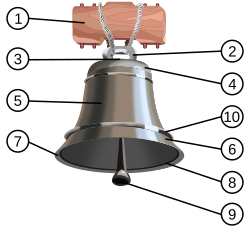 스윙을 위해 매달린 일반적인 타워 벨의 부품: 1. 요크 또는 헤드스톡 2. 캐논, 3. 크라운, 4. 어깨, 5. 허리, 6. 사운드 활, 7. 립, 8. 입, 9. 클래퍼, 10. 비즈 라인. |
기독교 교회 종은 테두리가 두꺼워진 컵 모양의 주물 금속 공명기와 안쪽 중앙에 매달린 추축 딱지 모양의 형태를 가지고 있다.주로 교회 꼭대기 종탑에 높게 설치돼 있어 주변 지역 주민들도 들을 수 있다.벨은 베어링 위에서 흔들릴 수 있는 헤드스톡에 매달려 있습니다.밧줄은 헤드스톡의 바퀴나 레버에 묶여 벨소리에 매달려 있다.벨을 울리기 위해, 벨을 휘두르며 줄을 당깁니다.이 동작에 의해 종 테두리가 흔들릴 때 딱따구리가 종 테두리 안쪽을 쳐서 종을 울립니다.일부 종은 완전한 원 바퀴를 가지고 있는데, 이것은 완전한 원 울림이 행해지는 영국처럼 큰 호를 통해 종을 흔들기 위해 사용됩니다.
휘둘러지지 않는 종은 "치임"으로, 외부 망치로 때리거나 내부 찰퍼에 부착된 밧줄로 때리는 것을 의미하는데, 이것은 러시아의 전통이다.
종소리 축복
어떤 교회에서는 종을 걸기 전에 축복을 받는 경우가 많다.
로마 가톨릭 교회에서는 적어도 프랑스에서는 11세기부터 종 세례라는 이름이 교회 종들의 의식적인 축복을 위해 붙여져 왔다.그것은 주교에 의해 성수로 종을 씻은 것에서 유래한다.그는 그 안에 크리스마스 없이 "약자의 기름"을 뿌리기 전에; 화가 난 향로가 그 아래에 놓이고 주교는 이 교회 성찬들이 종소리에 따라 악마를 도망치게 하고 폭풍으로부터 보호하고 신실한 사람들을 부를 수 있도록 기도한다.기도할 수 있게.[citation needed]
역사
교회 종소리가 기독교 교회에 도입되기 전에, 예배자들을 부르는 다른 방법들이 사용되었습니다: 트럼펫을 연주하거나, 나무 판자를 치거나, 소리를 지르거나,[40] 배달원을 사용하는 것입니다.서기 604년, 사비니아 교황은 공식적으로 [41][42]종 사용을 승인했다.이 틴티나뷸라는 단조 금속으로 만들어져서 [40]치수가 크지 않았다.더 큰 종은 7세기 말과 8세기에 캄파니아에서 유래한 금속을 주조하여 만들어졌다.그 종들은 결과적으로 [40]그 지역의 이름인 도시에서 캄파나와 놀라의 이름을 따왔다.이것은 AD [40][41][43]400년에 교회의 종소리의 기원이 놀라의 파울리누스에게 분명히 잘못된 귀속임을 설명해 줄 것이다.중세 초기에,[44] 교회 종은 유럽에서 흔해졌다.켈트족의 영향, 특히 아일랜드 [44]선교사들의 영향을 반영하면서, 그들은 북유럽에서 처음 흔해졌다.교회의 종을 사용하기 전에, 그리스 수도원들은 예배를 [44]알리기 위해 평평한 금속판을 울렸다.아일랜드의 영향을 받기 전에 서비스를 알리는 데 사용된 시그나와 캄파나는 [44]종이 아니라 의미론 같은 평평한 접시였을 수도 있습니다.영국에서 현존하는 가장 오래된 종 원은 [45]입스위치의 세인트로렌스 교회에 있다.
문학에서
교회 종소리는 시와 산문에서 많은 작가들에게 영감을 주었다.한 예로 영국 시인 레티시아 엘리자베스 랜던의 초기 시 '종소리'가 있다.
소음에 대한 논란
교회 종소리는 사람들의 잠을 방해하거나 방해하는 소음을 일으킬 수 있다.취리히에 있는 스위스 연방 공과대학교의 2013년 연구는 '취리히 광주의 약 2.5-3.5 퍼센트의 인구가 교회 종소리에 의해 하룻밤에 적어도 한 번 더 잠을 깨는 것을 경험한다'고 밝혔다.그것은 '예를 들어 자정에서 오전 6시 사이에 울리는 교회 종을 중단시킴으로써 깨어 있는 횟수를 99% 이상 줄일 수 있다' 또는 '종소리 음압 수준을 5dB까지 줄임으로써 약 75퍼센트 (...)'까지 줄일 수 있다고 결론지었다.[46]
네덜란드에서는 인근 [47]주민들이 겪는 교회 종소리 오염에 대한 소송이 있었다.불만은 보통 새로운 지역 주민(또는 밤이나 [48]낮에 소음에 익숙하지 않은 이웃에서[48] 밤을 보내는 관광객)에 의해 제기되지만 항상 그렇지는 않다.오래 전부터 익숙했던 주민들은 "이곳으로 이사오기 전에 알았어야 했다"며 "종소리는 [49][50]백 년 이상 거슬러 올라간다"고 반박한다.
이미지 갤러리
독일 헤세의 바트헤스펠트 수도원에서 1038년에 주조된 로울루스글로케
폴란드 크라쿠프의 지기스문트 벨로, 1520년 한스 베암에 의해 주조되었다.
비엔나 스테판스돔의 품메린
인도 케랄라 주 페야드 트리반드룸 성 자비에르 교회의 벨기에제 종
쾰른 대성당의 종
수오멘리나 교회의 종
투르나이 생자크교회의 종
「 」를 참조해 주세요.
레퍼런스
- ^ Church Words: Origins and Meanings. Forward Movement. August 1, 1996. ISBN 9780880281720. Retrieved August 16, 2012.
There are two sorts of liturgical bells in the history of the Christian Church-church bells in spires or towers used to call the faithful to worship, and sanctuary bells used to call attention to the coming of Christ in the Holy Eucharist.
- ^ a b Booth, Mark (February 11, 2014). The Sacred History: How Angels, Mystics and Higher Intelligence Made Our World. Simon and Schuster. p. 274. ISBN 9781451698589.
Church bells would be rung to drive away demons.
- ^ a b Cohen, I. Bernard (1990). Benjamin Franklin's Science. Harvard University Press. p. 119. ISBN 9780674066595.
The practice of ringing church bells to dissipate lightning storms and prevent their deleterious effects had a long tradition in Europe and had been a concomitant to the general belief in the diabolical agency manifested in storms. ... Typical inscriptions on church bells described their powr to "ward off lightning and malignant demons"; stated that "the sound of this bell vanquishes tempests, repels demons, and summons men," or exhorted it to "praise God, put to flight the coulds, affright the demons, and call the people"; or noted that "it is I who dissipate the thunders."
- ^ a b Lewis, James R. (2001). Satanism Today. ABC-CLIO. ISBN 9781576072929.
- ^ Adato, Joseph; Judy, George. The Percussionist's Dictionary. Alfred Music. p. 11. ISBN 9781457493829.
- ^ "What is the relationship between bells and the church? When and where did the tradition begin? Should bells ring in every church?". Coptic Orthodox Diocese of the Southern United States. 2020. Retrieved August 8, 2020.
- ^ Mary Cecil, 2nd Baroness Amherst of Hackney (1906). A Sketch of Egyptian History from the Earliest Times to the Present Day. Methuen. p. 399.
Prayers 7 times a day are enjoined, and the most strict among the Copts recite one of more of the Psalms of David each time they pray. They always wash their hands and faces before devotions, and turn to the East.
- ^ George Herbert Dryer (1897). History of the Christian Church. Curts & Jennings.
…every church-bell in Christendom to be tolled three times a day, and all Christians to repeat Pater Nosters (The Lord's Prayer)
- ^ Joan Huyser-Honig (2006). "Uncovering the Blessing of Fixed-Hour Prayer". Calvin Institute of Christian Worship.
Early Christians prayed the Lord's Prayer three times a day. Medieval church bells called people to common prayer.
- ^ "Church bells". Wisconsin Evangelical Lutheran Synod. July 25, 2017. Retrieved August 8, 2020.
- ^ a b Gerhard Kittel; Gerhard Friedrich (1972). Theological Dictionary of the New Testament, Volume 8. William B. Eerdmans Publishing Company. p. 224. ISBN 9780802822505. Retrieved October 26, 2012.
The praying of the Lord's Prayer three times a day in Did., 8, 2 f. is connected with the Jewish practice --> 218, 3 ff.; II, 801, 16 ff.; the altering of other Jewish customs is demanded in the context.
- ^ a b Roger T. Beckwith (2005). Calendar, Chronology, and Worship: Studies in Ancient Judaism and Early Christianity. Brill Publishers. p. 193. ISBN 9004146032. Retrieved October 26, 2012.
The Church had now two hours of prayer, observed individually on weekdays and corporately on Sundays – yet the Old Testament spoke of three daily hours of prayer, and the Church itself had been saying the Lord's Prayer three times a day.
- ^ Matthew: A Shorter Commentary. Continuum International Publishing Group. 2005. ISBN 9780567082497. Retrieved August 16, 2012.
Moreover, the central portion of the Eighteen Benedictions, just like the Lord's Prayer, falls into two distinct parts (in the first half the petitions are for the individuals, in the second half for the nation); and early Christian tradition instructs believers to say the Lord's Prayer three times a day (Did. 8.3) while standing (Apost. const. 7.24), which precisely parallels what the rabbis demanded for the Eighteen Benedictions.
- ^ James F White (September 1, 2010). Introduction to Christian Worship 3rd Edition: Revised and Enlarged. Abingdon Press. ISBN 9781426722851. Retrieved October 12, 2012.
Late in the first century or early in the second, the Didache advised Christians to pray the Lord's prayer three times a day. Others sought disciplines in the Bible itself as ways to make the scriptural injunction to "pray without ceasing" (1 Thess. 5:17) practical. Psalm 55:17 suggested "evening and morning and at noon," and Daniel prayed three times a day (Dan. 6:10).
- ^ Catechism Of The Catholic Church. Continuum International Publishing Group. 1999. ISBN 0-860-12324-3. Retrieved September 2, 2014.
Late in the first century or early in the second, the Didache advised Christians to pray the Lord's prayer three times a day. Others sought disciplines in the Bible itself as ways to make the scriptural injunction to "pray without ceasing" (1 Thess. 5:17) practical. Psalm 55:17 suggested "evening and morning and at noon," and Daniel prayed three times a day (Dan. 6:10).
- ^ Beckwith, Roger T. (2005). Calendar, Chronology And Worship: Studies in Ancient Judaism And Early Christianity. BRILL. ISBN 978-90-04-14603-7.
So three minor hours of prayer were developed, at the third, sixth and ninth hours, which, as Dugmore points out, were ordinary divisions of the day for worldly affairs, and the Lord's Prayer was transferred to those hours.
- ^ John P. Anderson (2009). Joyce's Finnegans Wake: The Curse of Kabbalah, Volume 2. Universal Publishers. ISBN 9781599429014. Retrieved August 16, 2012.
The Angelus is a Christian devotion in memory of the Incarnation. Its name is derived from the opening words, Angelus Domini nuntiavit Mariæ. It consists of three Biblical verses describing the mystery, recited as versicle and response, alternating with the salutation "Hail Mary!" and traditionally is recited in Catholic churches, convents and monasteries three times daily, 6:00 a.m., 12:00 noon and 6:00 p.m., accompanied by the ringing of the Angelus bell. Some High Church Anglican and Lutheran churches also use the devotion.
- ^ The Anglican Service Book: A Traditional Language Adaptation of the 1979 Book of Common Prayer, Together with the Psalter Or Psalms of David and Additional Devotions. Good Shepherd Press. September 1, 1991. ISBN 9780962995507. Retrieved August 16, 2012.
The Angelus: In many churches the bell is run morning, noon, and evening in memory of the Incarnation of God, and the faithful say the following prayers, except during Eastertide, when the Regina coeli is said.
- ^ a b The New Schaff-Herzog Encyclopedia of Religious Thought: Basilica-Chambers, Volume 2. Kessinger Publishing. 1952. p. 117.
The main use of bells has always been to announce the time of public worship. It is also a common Roman Catholic practise to ring the church bell at the consecration in the mass, as in some Protestant localities at the Lord's Prayer after the sermon, that those who are absent may unite themselves in spirit with the congregation.
- ^ The Valley's Legends & Legacies IV. Quill Driver Books. May 30, 2002. p. 223. ISBN 9781884995217. Retrieved October 26, 2012.
At the end of the sermon, both bells began to ring and continued ringing through the Lord's Prayer.
- ^ Bannatyne, Lesley (August 31, 1998). Halloween. Pelican Publishing Company. p. 22. ISBN 9781455605538.
Priests in tiny Spanish villages still ring their church bells to remind parishioners to honor the dead on All Hallows Eve.
- ^ Church Words: Origins and Meanings. Forward Movement. August 1, 1996. ISBN 9780880281720. Retrieved August 16, 2012.
It is also traditional that the church bells ring during the processions of Candlemas (the Feast of the Purification) and Palm Sunday.
- ^ Church Words: Origins and Meanings. Forward Movement. August 1, 1996. ISBN 9780880281720. Retrieved August 16, 2012.
It is traditional that no bells be rung from the last service on Maundy Thursday until the Great Vigil of Easter.
- ^ Church Words: Origins and Meanings. Psychology Press. August 1, 1996. ISBN 9780880281720. Retrieved August 16, 2012.
But even for Muslims who pray infrequently, the adhan marks the passage of time through the day (in much the same way as church bells do in many Christian communities) and serves as a constant reminder that they are living in a Muslim community.
- ^ Islamic Beliefs, Practices, and Cultures. Marshal Cavendish. September 1, 2010. p. 77. ISBN 9780761479260. Retrieved August 16, 2012.
Muslims living in predominantly Islamic lands, however, have the benefit of the call to prayer (adhan). In the same way that much of the Christian world traditionally used bells to summon the faithful to church services, so the early Muslim community developed its own method of informing the community that the time for prayer had arrived.
- ^ Church Words: Origins and Meanings. Forward Movement. August 1, 1996. ISBN 9780880281720. Retrieved August 16, 2012.
It became customary to ring the church bells to call the faithful to worship and on other important occasions, such as the death of a parishioner.
- ^ a b Fanthorpe, Lionel; Fanthorpe, Patricia (October 1, 2002). The World's Most Mysterious Objects. Dundurn. p. 100. ISBN 9781770707580.
- ^ Stahlschmidt, J. C. L. (1887). The Church Bells of Kent: Their Inscriptions, Founders, Uses and Traditions. London: Elliot Stock. p. 126.
- ^ a b 영국의 교회 종소리인 H B 월터스.1912년에 출판되어 옥스퍼드 대학 출판부에 의해 1977년에 재발행되었다. pp156-160
- ^ 밥 트리플스, 유튜브에서 종소리 완전무결
- ^ 로마 미사 총지시서, 150
- ^ 에레라, 매튜 D. (2005)생투스 벨스. 그들의 역사와 가톨릭 교회에서의 사용.아보머스 게시판2014년 11월 11일 취득.
- ^ Age Concern Shropshire (May 9, 2005). "Recollections of a Wartime Childhood". WW2 People's War. BBC.
- ^ "Ringing of Church Bells (1943)". Parliamentary Debates (Hansard). House of Lords. April 20, 1943. Retrieved July 2, 2021.
- ^ "Ban on Ringing of Church Bells during WW2".
- ^ "Church Bell Ringing (Removal of Restrictions)". Parliamentary Debates (Hansard). House of Commons. May 27, 1943. Retrieved July 2, 2021.
- ^ "Residents say flood-hit German towns got little warning AP News". Associated Press. July 24, 2021.
- ^ Gathmann, Florian (July 23, 2021). "Catastrophic Flooding Spotlights Germany's Poor Disaster Preparedness". Der Spiegel.
- ^ "Starcross SOS church bells to warn of flood - BBC News". BBC News. February 24, 2019.
- ^ a b c d Buse, Adolf (1858). S. Paulin évêque de Nole et son siècle (350-450) (in French). Translated by Dancoisne, L. Paris: H. Casterman. pp. 415–418.
- ^ a b Roger J. Smith (1997). "Church Bells". Sacred Heart Catholic Church and St. Yves Mission.
Bells came into use in our churches as early as the year 400, and their introduction is ascribed to Paulinus, bishop of Nola, a town of Campania, in Italy. Their use spread rapidly, as in those unsettled times the church-bell was useful not only for summoning the faithful to religious services, but also for giving an alarm when danger threatened. Their use was sanctioned in 604 by Pope Sabinian, and a ceremony for blessing them was established a little later. Very large bells, for church towers, were probably not in common use until the eleventh century.
- ^ Henry Beauchamp Walters (1908). Church Bells. A. R. Mowbray & Company. p. 4.
- ^ Kathy Luty; David Philippart (1997). Clip Notes for Church Bulletins - Volume 1. ISBN 9781568541693.
The first known use of bells in churches was by a bishop named Paulinus in the year 400.
- ^ a b c d Bells. Catholic Encyclopedia.
- ^ Worthington, Mark (September 10, 2009). "Oldest ring of bells played again". BBC News. Retrieved September 10, 2009.
- ^ Omlin, S.; Brink, M. (October 2013). "Awakening effects of church bell noise: geographical extrapolation of the results of a polysomnographic field study 1". Noise & Health. Medknow Publications. 15 (66): 332–41. doi:10.4103/1463-1741.116582. PMID 23955130.
- ^ "Kerkklok op mute". RTL Nieuws. August 2, 2019. Retrieved October 8, 2019.
- ^ a b "Kerkklok beiert hotelgasten wakker". Hart van Nederland. May 12, 2018. Retrieved October 8, 2019.
- ^ Niels Dekker (July 26, 2015). "Klokgelui van de kerken, een zegen of een vloek?". Algemeen Dagblad. Retrieved October 8, 2019.
- ^ Geraldina Metselaar (February 25, 2018). "Geluid van carillon drijft omwonende tot wanhoop". Algemeen Dagblad. Retrieved October 8, 2019.


